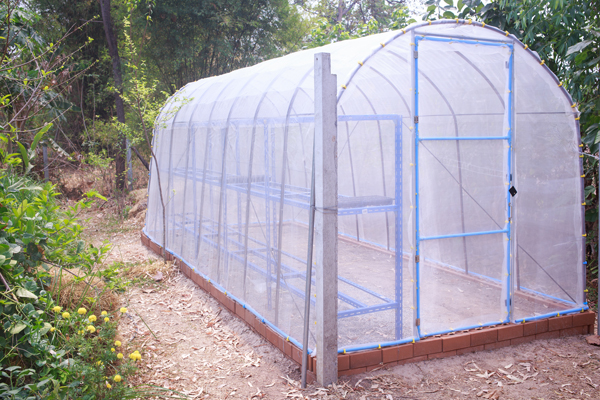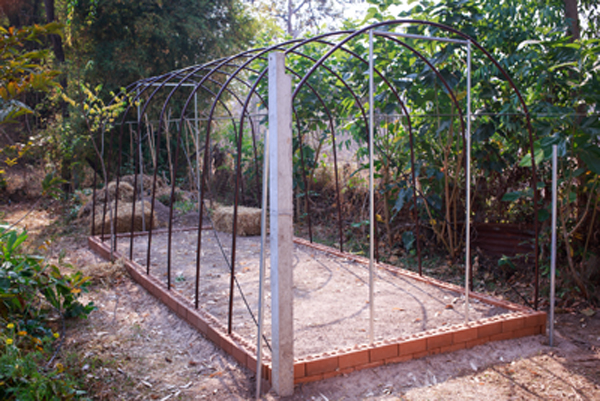
We recently completed a mesh hoop house in our forest garden. Our climate is tropical, so we wanted a mesh fabric covering that blocks the intensity of the sun and allows plenty of ventilation. The hoop house will be used to grow vegetable starts for the garden, microgreens and tomatoes in large containers. The project was inspired by a Curtis Stone video. Curtis goes by the name Urban Farmer on YouTube. In this video he interviews Chris Thoreau, a guy in Vancouver who makes about $75,000 – $100,000/year in a shipping container greenhouse. (That’s more money than many farmer’s earn on acres of land.) His greenhouse is 40’ long. Ours is 20’ long (same size as a small shipping container) and costs much less — around $300 instead of tens of thousands of dollars. (For added inspiration, see previous blog post: How to Make $100,000 Farming 1/2 Acre You Don’t Own)

Here are some of the benefits of greenhouse insect netting: protection from insects and birds (netting can be opened to allow access to pollinators at the appropriate time), moisture retention, good ventilation, shelter from bad weather, and about 16% shading to reduce sunlight intensity but still provide plenty of sunlight (vegetables like lots of sunlight, but not too much). This is a do-it-yourself friendly product that can be attached to numerous types of hoop house frames (PVC, electrical conduit, etc.). We bought a local brand of insect netting through a hardware store. If you can’t find insect netting where you live, consider searching online for brands such as GrowCover insect netting (UV resistant).
This is not a detailed how-to build blog post in part because the whole thing was improvised as we went along. Just to be clear, this hoop house is far from ideal. The main challenge was finding good materials in our rural area. Consequently, the greenhouse may have to be replaced in a few years. Even so, the potential payoff is high enough to justify the time and effort involved in my opinion. Next time I will probably make the frame with steel tubing. I’d bend my own metal hoops using a hoop bender like the one in the following YouTube video. Galvanized cattle panels attached to steel pipe hoops would be a winning combination, unfortunately cattle panels are not available in our area.
Here’s another video of an identical hoop bender by another company. https://www.youtube.com/watch?v=ctkKwoo0JH4 There are lots of other hoop bender and hoop greenhouse videos on YouTube.
Notes: The self-locking CEB foundation uses no cement. The foundation raises the greenhouse above grade to help prevent flooding. The shelving is made with standard store bought shelving that bolts together. A pre-existing concrete post, some metal pipe posts, rebar anchors, steel sway braces and lots of galvanized wire help protect against wind damage. Nothing will be grown in the soil in the greenhouse. It seems easier to control soil quality, moisture and drainage in containers. Mostly we’ll be using potting trays. The tomatoes will be grown in large plastic totes. The PVC pipe door frame was time consuming and not fun to build. Next time I’d do the door differently.

A winter snow would like to cover my containers “in bulk” and I would like something that my chickens can’t open. BUT I would like it permeable, so the plants get rain? Do you think it will work for that? I can use it in the summer to grow some plants on too but I only want to water to supplement.
A mesh or shade cloth hoop house would likely keep the snow off while allowing at least some moisture through. Unfortunately in the winter it would also allow any retained heat within to escape.